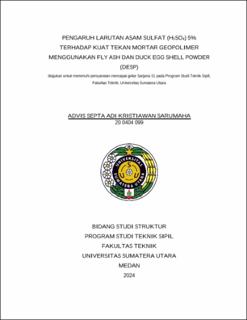Pengaruh Larutan Asam Sulfat (H2SO4) 5% Terhadap Kuat Tekan Mortar Geopolimer Menggunakan Fly Ash dan Duck Egg Shell Powder (DESP)
Abstract of Final Project : The Effect of 5% Sulfuric Acid (H2SO4) Solution on the Compressive Strength of Geopolymer Mortar Using Fly Ash and Duck Egg Shell Powder (DESP)

Date
2024Author
Sarumaha, Advis Septa Adi Kristiawan
Advisor(s)
Karolina, Rahmi
Metadata
Show full item recordAbstract
Geopolymer is an inorganic material that forms a network of covalent bonds, which is non-crystalline (amorphous). This network is created through a chemical reaction between chemically reactive aluminosilicate powder and an alkaline solution, resulting in a strong three-dimensional polymer structure. One common base material for geopolymers is fly ash. Fly ash is a non-hazardous waste that, when used as a construction material, can reduce CO2 emissions generated during Portland cement production. Additionally, organic waste containing alumina (Al), silicate (Si), and calcium oxide (CaO) can also be utilized as a precursor for geopolymerization, such as Duck Egg Shell Powder (DESP).The main objective of this research is to assess the durability of geopolymer mortar in a corrosive environment. The corrosive environment is simulated using a 5% sulfuric acid (H2SO4) solution (pH = 1). Geopolymer mortar, in the form of 5x5x5 cm cubes, is prepared with varying substitutions of DESP for fly ash (0%, 10%, 30%, and 50%). Sodium Hydroxide (NaOH) and Sodium Silicate (Na2SiO3) are used as alkali activators with different molarities (8M, 12M, and 16M). The geopolymer mortar specimens are immersed for 7, 14, and 28 days. The resistance properties are evaluated based on compressive strength values and mass deformation after immersion. The research results indicate that higher substitution percentages lead to faster setting times but lower compressive strength. Furthermore, increasing NaOH molarity results in better compressive strength
Collections
- Undergraduate Theses [1512]
